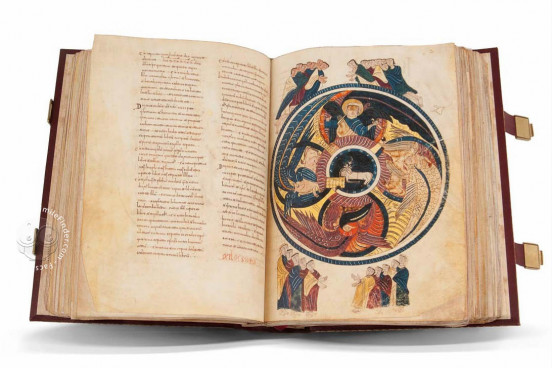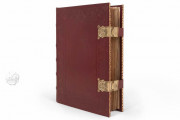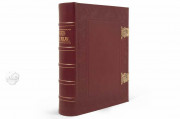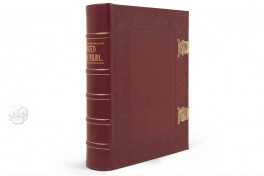The San Millán Codex is an illuminated copy of the commentary of Beatus of Liébana on the Christian scriptural book of the Apocalypse. Its writing and illumination were carried out in northern Spain over more than a century, probably beginning in the last quarter of the tenth century and ending in the first quarter of the twelfth. The manuscript's figural paintings include nineteen vignettes, most without frames and with blank parchment grounds. The remaining figural subjects are in thirty framed miniatures, three of which occupy a full page and a portion of the facing page.
The manuscript opens with a painted incipit page and a page given over to a representation of a cross with a painted architectural surround (fols. 1r-v). There follows the Apocalypse—Saint John the Divine's vision of the events leading to the end of time—with commentary and ancillary texts (fols. 2r-233r). The manuscript continues with Saint Jerome's commentary on Daniel, which ends in medias res (fols. 233v-282v).
Two Phases, Five Illuminators
The text was written in two phases (fols. 1-228 and fols. 229-282), although it is uncertain how far apart in time. The illumination was executed in two campaigns not necessarily synchronous with the two scribal campaigns. The vignettes were probably painted by two illuminators working around the time of the first scribal campaign. They left many spaces reserved for paintings blank, and another team of three illuminators working after the second scribal campaign provided miniatures in some of those blank spaces, but not all.
A Change in Painting Style
The seemingly weightless figures of the first pair of illuminators (working in the tenth century) are characterized by schematic heads with large almond-shaped eyes. Contrasts of color are exploited for expressive effect. The miniatures of the second team of illuminators (working in the twelfth century) are dense compositions featuring bulkier figures and less color contrast.
The Case for Valeránica
It is unknown whether the two writing campaigns and/or the two painting campaigns took place in one location. A case has been made for locating the early illumination—the vignettes—at the monastery of Saints Peter and Paul at Valeránica based on stylistic similarities to manuscripts known to have been made there, including the Visigothic-Mozarabic Bible of San Isidoro. The vignette of Jacob Wrestling with the Angel in the San Millán Codex (fol. 36v) is remarkably like the treatment of the same subject in the Bible (fol. 8r).
The Endurance of Visigothic Script
Although the two campaigns of writing the Latin text cannot be precisely dated, they are thought to be separated by generations, generations during which the script of the Iberian Peninsula remained the idiosyncratic Visigothic Minuscule, with its open-a and t with a split bar.
At San Millán in the Early Modern Period
The manuscript owes its nickname to its home in the early modern period, San Millán de la Cogolla, where there has been a Christian monastery since the sixth century. How early the manuscript was there and whether any of its production took place there is unknown, although it is possible that it may have migrated there before the second campaign of illumination. It entered the collection of the Real Academia de la Historia in 1851. The manuscript was conserved and rebound in 1974.
_____
For more information on the Beatus model, read our blog article by Amy R. Miller (PhD, Medieval Art History, University of Toronto).
We have 2 facsimiles of the manuscript "Beatus of Liébana - San Millán Codex":
- El Beato de San Millán de la Cogolla facsimile edition published by Edilan, 1999
- Beato de San Millán facsimile edition published by Testimonio Compañía Editorial, 2002





